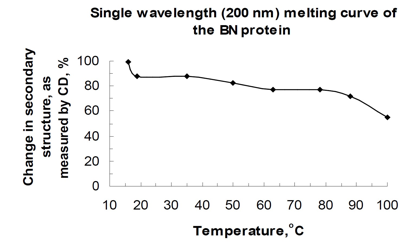Question: Circular dichroism (CD) is a technique
used for determining the secondary structure (?-helix and …
Circular dichroism (CD) is a technique
used for determining the secondary structure (?-helix and ?-pleated
sheet) of a protein. The authors
took CD spectra of the protein at varying temperatures at various
wavelengths. Then they plotted the results obtained at 220 nm. The
results are an indication of the integrity of the secondary
structure of the BN protein. A decrease from 100% indicates a loss
of secondary structure integrity. The results are shown
below.
a. What do these data tell you about
the stability of the protein at various temperatures?

b. The authors next carried out
fluorescence studies in order to obtain additional information
concerning the three-dimensional
structure of the BN protein. Specifically, they were trying to
determine if there was an interaction between Tyr 63 and Trp 26,
and for this reason, they decided to study the microenvironment of
the Trp residue. Only tryptophan and tyrosine are fluorophores, which means they are capable of undergoing
fluorescence. They found that
a single tryptophan residue emits light at 330 nm upon excitation
at 295 nm. There are several
ions and small molecules that have the ability to quench fluorescence. This means that upon excitation at
295 nm, the tryptophan will transfer its energy to the quenching
agent rather than releasing the energy in emitted light. Cesium (Cs+) ions, iodide (I-
ions) and acrylamide are capable of quenching the tryptophan
residue’s fluorescence–that
is, if these quenching agents can make suitable contact with the
tryptophan. Neither of the
quenching agents worked very well. The investigators found that
there was no quenching at all with cesium ions and that quenching
efficiencies with iodide and acrylamide were very low.
What do these observations tell you
about the microenvironment of the tryptophan residue? Is an
interaction between Tyr 63 and Trp 26 likely?



